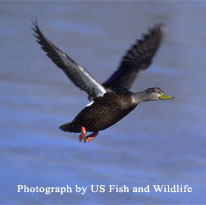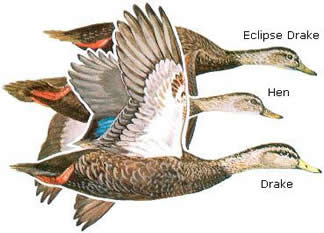Wildlife - Species

Species Specific Regulations
American Black Duck
Licenses: Hunting License required. Migratory Bird Hunting and Conservation Stamp (Federal Duck Stamp) that is validated by the hunter signing the stamp in ink across the face of the stamp
Limits: Please see Migratory Bird Regulations for any game zones restrictions or Limitations.
American Black Duck (Anas rubripes)

Description
The American black duck often flocks with mallards, in which they look quite similar to the hen. Look for the white wing lining in contrast to the very dark body plumage to differentiate the two.
Average Size
Black ducks have an average length of 24 inches and an average weight of 2 3/4 pounds.
Range
A bird of the eastern states, primarily the Atlantic flyway and, to a lesser extent, the Mississippi. Black ducks are a winter resident to the state of South Carolina.
Preferred Habitat
The black duck is more common in freshwater during the breeding season and brackish or saltwater while overwintering. During the winter months they are commonly found in managed impoundments, emergent wetlands, beaver ponds, flooded areas, and fields.
Typical Flock Pattern

Wings

Food Habits
Black ducks have a varied diet including plant material, such as seeds, roots, tubers, stems, and leaves, as well as animal material such as aquatic insects, crustaceans, and fish.
Reproduction
Pair bonding occurs during the fall and winter months. Nesting occurs on wooded or grassy islands, uplands, marshes, or even cropland. The female digs a shallow bowl in the ground lined with plant material and down feathers. Black ducks lay 6-14 white or cream colored eggs.
Sound
Drakes kwek-kwek, and hens quack. Similar to those of the mallards..
Behavior
- Shy and wary, regarded as the wariest of all ducks.
- Flight is slow and swift, usually fly in small flocks.
- Runs, walks, and dives easily.
- Mated pairs are fairly tolerant of each other during the breeding season with aggressive behavior only arising if a rival male intrudes.
- Frequently found in small flocks during the nonbreeding season.
Citations, Publications and Recommended Literature
U.S. Fish & Wildlife Service, Federal Duck Stamp Office Presents: North American Waterfowl (Adobe PDF file)
Longcore, Jerry R., Daniel G. Mcauley, Gary R. Hepp and Judith M. Rhymer. 2000. American Black Duck (Anas rubripes), The Birds of North America Online (A. Poole, Ed.). Ithaca: Cornell Lab of Ornithology; Retrieved from the Birds of North America Online
For more information, please see:
South Carolina waterfowl hunters 16 and older are required by state law to obtain a state migratory waterfowl permit and Migratory Game Bird permit. Both permits must be in the hunter's possession while hunting or transporting legal waterfowl. A state waterfowl permit is included with the Lifetime Senior, Lifetime Gratis and Disability Licenses. S.C. residents who hold a Lifetime Senior or Lifetime Gratis License are not required to have a Migratory Game Bird permit.
National Migratory Bird Harvest Information Program (HIP)
The waterfowl permits and HIP permits are available from select DNR offices and from hunting and fishing license agents.